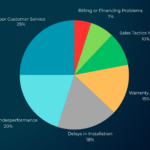
Despite a temporary industry-wide contraction currently taking place, residential solar growth is part of a broader trend in the U.S. solar market, which is expected to see substantial expansion in the coming years. The Mid-Atlantic region is just getting started.

Source: EcoWatch
Mid-Atlantic growth projections and market dynamics
The U.S. solar market’s Mid-Atlantic region surge is seeing growth in community and C&I installers, attributed to favorable policies like the Investment Tax Credit (ITC), the Inflation Reduction Act (IRA), and local programs that have boosted the region’s investment in the sector. The extension of the ITC, as part of the IRA, is particularly influential, providing a stable foundation for federal support of solar installations. The growth is not without its challenges, such as interconnection issues and supply chain constraints. Still, the overall outlook remains positive? in the long term.

Source: PV Magazine
Regional developments
In the Mid-Atlantic, states like New Jersey, Virginia, and Maryland play pivotal roles in the region’s solar boom. Despite some setbacks in its solar programs, New Jersey continues to invest in offshore wind and aims for substantial rooftop renewable energy targets. Virginia has overtaken New Jersey in solar installations, driven by strong policies like the Virginia Clean Economy Act and incentives for solar power generation. Maryland, known for its progressive energy policies, has seen a significant increase in solar capacity and is implementing innovative programs like the Community Solar Grant pilot program. In 2019, Maine introduced the Net Energy Billing (NEB) and Distributed Generation (DG) programs as incentives to encourage new solar development. NYSERDA has shifted its renewable energy objectives to enhance access to community solar benefits for low-income communities. This includes offering incentives to both consumers and developers through initiatives like the Solar for All program.
Challenges and innovative solutions in solar energy
The expansion of solar energy in the Mid-Atlantic also faces challenges like interconnection bottlenecks, community engagement issues, and workforce shortages. However, innovative solutions are being employed to overcome these barriers. For instance, developers are using brownfield sites with existing distribution or transmission connections to support clean energy projects, and commercial rooftops are being targeted to circumvent interconnection review queues. Community engagement strategies, such as Community Benefits Agreements, are being used to garner local support for renewable projects?.
National energy mix shift
A significant shift in the energy mix is expected at a national level, with solar and wind energy set to surpass coal in electricity generation. This transition is driven by massive growth in solar power and a shift from coal to natural gas. The U.S. Energy Information Administration (EIA) predicts a 38% increase in solar electricity generation from its previous year’s level, with wind and solar together expected to account for over 16% of all electricity generation??.

Source: EIA
The Mid-Atlantic region is an emerging player in the growing solar market in the United States. Driven by supportive state policies, federal incentives, and innovative strategies, this region contributes significantly to the nation’s transition to a clean, renewable energy-driven economy.
Economic impacts and investment trends
Investments of $100 billion have been realized, alongside $82 billion in distributed renewables and heat pumps. In 2022, states also provided $24 billion in tax incentives to attract projects.
Substantial investments and federal incentives buoy the economic landscape of the solar industry in the Mid-Atlantic. The solar sector’s growth contributes significantly to the region’s job creation and economic development. The influx of investments, particularly in states like New Jersey, Virginia, and Maryland, enhances solar capacity and supports local economies?.
Solar energy’s role in grid resilience
As the Mid-Atlantic region continues to grow its solar capacity, the role of solar energy in enhancing grid resilience and reliability is becoming increasingly significant. Solar installations, especially when coupled with energy storage solutions, are contributing to a more stable and resilient energy grid, which is crucial for meeting peak demand periods and ensuring energy security?.
?Environmental and health benefits of solar
The shift towards solar energy in the Mid-Atlantic region is also yielding notable environmental and public health benefits. By reducing reliance on fossil fuels, solar power is helping to lower greenhouse gas emissions and improve air quality, contributing to healthier communities and aiding in the fight against climate change?.
Solar energy’s contribution to energy independence
Solar energy growth in the Mid-Atlantic also contributes to the nation’s energy independence. By increasing the share of domestically produced renewable energy, the region is helping to reduce dependence on imported fossil fuels and enhancing national energy security.?
Projections and outlook
The Mid-Atlantic region’s solar market is poised for continued growth and innovation. With ongoing advancements in solar technology, declining costs, and supportive policies, the region is expected to maintain its trajectory and emerge as a leader in solar energy production in the United States??? from residential to community and commercial solar.
As we witness a national shift in the energy mix and a rise in the economic impact of solar investments, now is the time to engage. Whether you are in New Jersey, Virginia, Maryland, or any other state, Solar Insure provides 30-Year Monitoring and Warranty for homeowner success. Embrace the delivery of peace of mind to grow America’s clean energy and secure your role in a market. Reach out to Solar Insure today and take the first step towards becoming a certified installer in an emerging region taking leadership in solar energy innovation.


